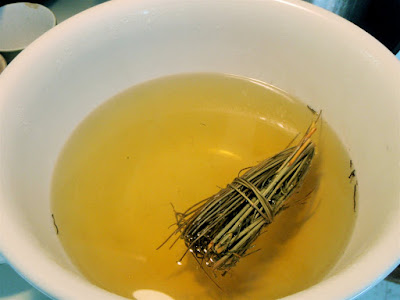
If your soul screams for yet another post about a sour tea made from wild ingredients, read on. If you'd rather read about designer cupcakes, might I suggest another food blog.
To begin, let's play a little game of word association. I'm going to say a word, and I want you to think of the first word that immediately jumps into your mind. Ready?
Me: sumac.
You: POISON!
But have no fear. The only similarities between poison sumac and regular -- or "delicious" -- sumac are literary. Though they share a name, they look nothing alike.

And yet a hairy, red, seed-studded head of common sumac just doesn't look like something you'd want to eat. And it isn't. But it is something that you want to drink. Simply muddle a ripe head in cool water, let stand for about ten minutes, strain, and drink. The resulting liquid should be a shade of salmon that can only be described as "lovely." It is to pink lemonade as manna is to food.

Besides za'atar, this simple drink is my only experience ingesting sumac, though I could easily imagine a sumac syrup splashed into champagne, among other possibilities.

Though I have little desire to experiment given the quality of sumac tea and the ease with which it is made. Sumac tea is tart and fruity, part citrus, part berry. It is a dead ringer for a splash of pure cranberry juice in water, which is something I drink all summer but will never need to pay for again. Sumac-ade, as it is often called, is just as good if not better, not to mention carbon-neutral and obtainable without the exchange of currency. Nor does it come in a wasteful container; I carried mine home in a hat.
Brewing a cool, refreshing glass of tangy sumac jus doesn't even require a heating element, and the process could therefore predate the invention of fire. Forget about so-called organic food flown in from China: this stuff is the essence of sustainability.
----------------------------------
Sumac Agua Fresca (aka Rhus Juice)
serves 6
Ingredients:
1 quart of water
1 ripe sumac berry cluster (dark red, picked in mid-summer to fall)
To test a berry cluster for flavor, gently rub it and then lick your fingers. They'll taste tangy if you've got a winner.
Twist or snip off the berry head. Thoroughly muddle it in the water using a wooden spoon or your fingers. Pour through a fine strainer or cheesecloth removing all seeds and hairs, which can irritate the throat.
Sweeten if desired. Serve room temperature or cold. Connect with nature.















